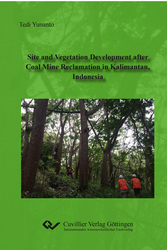| Fachbereiche | |
|---|---|
| Buchreihen (96) |
1378
|
| Nachhaltigkeit |
3
|
| Gesundheitswesen |
1
|
| Geisteswissenschaften |
2364
|
| Naturwissenschaften |
5406
|
| Mathematik | 229 |
| Informatik | 319 |
| Physik | 980 |
| Chemie | 1363 |
| Geowissenschaften | 131 |
| Humanmedizin | 243 |
| Zahn-, Mund- und Kieferheilkunde | 10 |
| Veterinärmedizin | 108 |
| Pharmazie | 147 |
| Biologie | 835 |
| Biochemie, Molekularbiologie, Gentechnologie | 121 |
| Biophysik | 25 |
| Ernährungs- und Haushaltswissenschaften | 45 |
| Land- und Agrarwissenschaften | 1004 |
| Forstwissenschaften | 201 |
| Gartenbauwissenschaft | 20 |
| Umweltforschung, Ökologie und Landespflege | 148 |
| Ingenieurwissenschaften |
1792
|
| Allgemein |
98
|
|
Leitlinien Unfallchirurgie
5. Auflage bestellen |
|
Erweiterte Suche
Site and Vegetation Development after Coal Mine Reclamation in Kalimantan, Indonesia
Tedi Yunanto (Autor)Vorschau
Leseprobe, PDF (1,3 MB)
Inhaltsverzeichnis, PDF (620 KB)
Coal is a rock composed of organic and inorganic materials, which contains 50% or more than 75% organic material (Fig. 1). The organic matter mostly consists of carbon ©, but is also comprised of hydrogen (H), oxygen (O), sulphur (S) and nitrogen (N). Besides organic matter, coal contains some inorganic compounds (minerals) and water (H2O). Naturally, coal is formed from vegetation that has been consolidated between other rock strata and altered by the combined effects of pressure and heat over millions of years to ultimately form coal seams (World Coal Institute, 2005).
| ISBN-13 (Printausgabe) | 9783736999411 |
| ISBN-13 (E-Book) | 9783736989412 |
| Buchendformat | A5 |
| Sprache | Englisch |
| Seitenanzahl | 272 |
| Auflage | 1. |
| Erscheinungsort | Göttingen |
| Promotionsort | Göttingen |
| Erscheinungsdatum | 28.12.2018 |
| Allgemeine Einordnung | Dissertation |
| Fachbereiche |
Forstwissenschaften
|
| Schlagwörter | organic, coal, inorganic materials |








